How Often Does a Septic Tank Need to Be Emptied?
Septic Tank emptying is not an easy job and without industry experience and the correct know-how, can easily go wrong.
What Is a Septic Tank?
A septic tank is a watertight container usually buried out of sight. Constructed from concrete, fibreglass or polyethylene it holds wastewater from a property in a rural area where it has not been possible to connect to the central sewer system.
A septic tank handles all the wastewater from bathrooms and kitchens, digesting organic waste and separates other matter such as oil and grease. Effluent or liquid wastewater eventually exits the septic tank into a drainage field, where it percolates into the soil, while solids and scum are filtered out by the septic tank system.
How Often Do You Have to Empty a Septic Tank?
To avoid any problems with a septic tank, it is very important that the tank is emptied on a regular basis. Well designed and professionally installed 1,000-gallon tanks as well as other smaller tanks require an annual clearance. The frequency may differ slightly depending on water usage and the number of people residing at the property.
A professional plumber or drainage engineer can pump, empty and clean your tank, while they can also perform essential maintenance and septic tank repairs. They will also be able to advise on how frequently the septic tank needs to be emptied.

If you haven’t your septic tank emptied on a regular basis, there may be some tell-tale signs that there is an issue.
- Plumbing system gurgling sounds
- Water and sewage backing up into the property
- Foul odours around the septic tank and drain field
- Damp spots or standing water near the septic tank
Pros and Cons of Septic Tanks
A well-maintained septic tank that undergoes scheduled maintenance work and is emptied frequently will be a perfectly adequate wastewater system for any property. There are in fact a number of pros for having a septic tank.
Pros
- Cost – a septic tank is an affordable option for wastewater, with a reasonable installation cost. Septic tanks allow properties to process their water independently from the public sewers saving on water bills.
- Durability – a well-maintained tank rarely requires replacement, with plastic and concrete tanks lasting up to 40 years.
- Environment – septic tanks remove bacteria before releasing the water into the soil. Septic tanks provide a form of wastewater management at rural locations.
Cons
- Maintenance – septic tanks require routine pumping to eliminate solid waste. If tank emptying does not take place, this can lead to sewage backing up to the property.
- Water backup – septic lines are more likely to end up damaged or blocked when unsuitable items are flushed down the toilet such as baby wipes or feminine hygiene products.
- Rupturing pipes – are a possibility due to tree roots or digging accidents can damage piping.
How Many Years Does a Septic Tank Last For?
Septic tanks are generally made of concrete, steel or fibreglass and can last anywhere between 20 and 40 years. The lifespan will depend on a number of factors including how often the septic tank is emptied, serviced and the amount of usage it faces.
When you have a septic tank installed, the professional engineer will be able to advise on the frequency of septic tank pumping. Clearing the tank of waste and sludge can also be scheduled so that you don’t need to worry about it. A regular service will spot any problems early before they become a bigger issue, and this in turn will increase the septic tank life span.
Septic Tank Materials
Septic tanks constructed from steel may rust which can shorten the lifespan of the tank to around 20 years, while plastic and concrete tanks can last up to 30 or 40 years. The proper installation of a septic tank is another key factor in how long it is likely to last, as if installed by a professional, the chances of any issues are minimised.
Does a Septic Tank Need a Soakaway?
Septic tanks require a soakaway as the effluent or wastewater has normally only had one level of treatment. At this stage, the water is still hazardous to the environment. The soakaway, or drainage field delivers further treatment to this water, further cleansing it so that it be released safely back into the soil as ground water.
How Far Away From the House Should a Septic Tank be Located?
Septic tanks should be located as far away from the house as is practically possible, with a minimum of 7 metres from the house. When installing a septic tank other considerations include how it will be emptied. Good access will be required from the road for tankers to service the septic tank and another key point to be wary of is that the septic tank should not be located in an area prone to flooding.
A professional septic tank expert will have the latest legislation and guidance information to help lead any installation, and we heavily recommend consulting an expert.
For an overview of the recent regulation changes, please do have a read of our ‘2020 Septic Tank Law Changes’ article.

